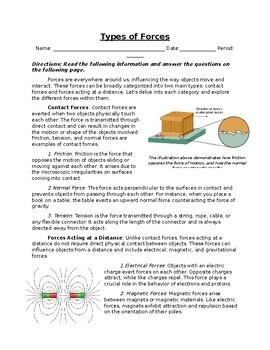Types of Forces: Informational Text, Images, and Assessment
Greg Powers
8 Followers
Grade Levels
4th - 9th, Homeschool
Subjects
Resource Type
Standards
NGSS3-PS2-3
NGSSMS-PS2-4
NGSSMS-PS2-3
NGSS5-PS2-1
NGSSMS-PS2-5
Formats Included
- Word Document File
Pages
3 pages
Greg Powers
8 Followers
Also included in
- This bundle contains 5 assignments over the following topics on Forces and Motion:· Distance-Time Graphs and Speed· Newton’s Three laws of Motion· The Law of Universal Gravitation· Types of Forces· Unbalanced Forces and MotionEach of the above topics contains a worksheet with informational text andPrice $13.46Original Price $14.95Save $1.49
Description
This resource is great for a an introductory or extension assignment, as well as a sub plan assignment, no outside sources are needed. The worksheet utilizes informative text and illustrations to provide a foundation of knowledge over the following standard:
SC.6.P.13.1 – Investigate and describe types of forces including contact forces and forces acting at a distance, such as electrical, magnetic, and gravitational.
A 10 question assessment is on page 2 of the worksheet that assesses the student over the informative text section. There is also an answer key on page 3 for teacher use. The entire Word document is editable.
Total Pages
3 pages
Answer Key
Included
Teaching Duration
40 minutes
Last updated 5 months ago
Report this resource to TPT
Reported resources will be reviewed by our team. Report this resource to let us know if this resource violates TPT’s content guidelines.
Standards
to see state-specific standards (only available in the US).
NGSS3-PS2-3
Ask questions to determine cause and effect relationships of electric or magnetic interactions between two objects not in contact with each other. Examples of an electric force could include the force on hair from an electrically charged balloon and the electrical forces between a charged rod and pieces of paper; examples of a magnetic force could include the force between two permanent magnets, the force between an electromagnet and steel paperclips, and the force exerted by one magnet versus the force exerted by two magnets. Examples of cause and effect relationships could include how the distance between objects affects strength of the force and how the orientation of magnets affects the direction of the magnetic force. Assessment is limited to forces produced by objects that can be manipulated by students, and electrical interactions are limited to static electricity.
NGSSMS-PS2-4
Construct and present arguments using evidence to support the claim that gravitational interactions are attractive and depend on the masses of interacting objects. Examples of evidence for arguments could include data generated from simulations or digital tools; and charts displaying mass, strength of interaction, distance from the Sun, and orbital periods of objects within the solar system. Assessment does not include Newton’s Law of Gravitation or Kepler’s Laws.
NGSSMS-PS2-3
Ask questions about data to determine the factors that affect the strength of electric and magnetic forces. Examples of devices that use electric and magnetic forces could include electromagnets, electric motors, or generators. Examples of data could include the effect of the number of turns of wire on the strength of an electromagnet, or the effect of increasing the number or strength of magnets on the speed of an electric motor. Assessment about questions that require quantitative answers is limited to proportional reasoning and algebraic thinking.
NGSS5-PS2-1
Support an argument that the gravitational force exerted by Earth on objects is directed down. “Down” is a local description of the direction that points toward the center of the spherical Earth. Assessment does not include mathematical representation of gravitational force.
NGSSMS-PS2-5
Conduct an investigation and evaluate the experimental design to provide evidence that fields exist between objects exerting forces on each other even though the objects are not in contact. Examples of this phenomenon could include the interactions of magnets, electrically-charged strips of tape, and electrically-charged pith balls. Examples of investigations could include first-hand experiences or simulations. Assessment is limited to electric and magnetic fields, and limited to qualitative evidence for the existence of fields.



